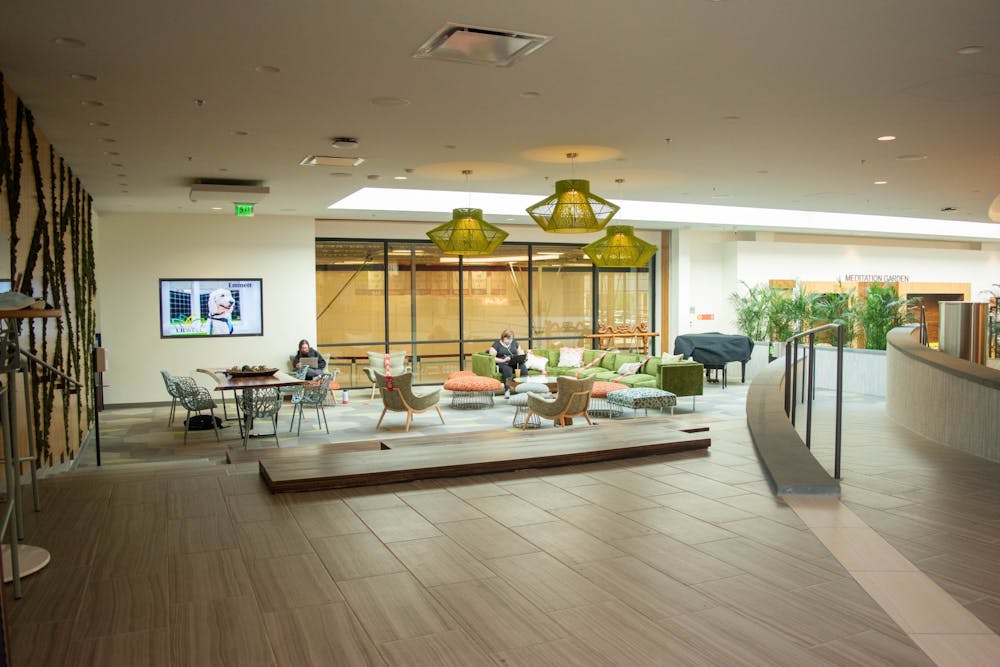Editor's Note: This story has been updated.
As University of Richmond Health Promotion Director Heather Sadowski described the purpose of Reflexology, the therapeutic practice that inspired the indoor stone path students are meant to walk on without shoes, she explained how each part of the Well-Being Center had been intentionally designed to engage in various parts of self-care and improve well-being.
Sadowski wants students to explore the center and discover what works best for their wellness journey, she said.
The Well-Being Center, which had limited operations last year due to the COVID-19 pandemic, is now completely open to students and staff, and its staff is developing programming and other offerings to create a holistic well-being journey that students can tailor to their needs, Sadowski said.
It offers unique experiences and relaxation tools such as a meditation garden, massage chairs and a grand piano for anyone willing to play to an audience.
Sadowski has been at work over the past year developing the programs offered at the Well-Being Center. In her work, Sadowski emphasizes a holistic approach to well-being that is the focus of the Well-Being Center’s operation and management, she said.
The center focuses on five key elements of well-being -- exercise, nutrition, self-care, mindfulness and sleep – that were highlighted in a 2018 survey in which UR students were asked to identify areas of concern regarding their academic success, according to the center’s website.
The center’s key focus on nutrition, for example, is represented at Organic Krush, the organic dining option in the building. Next to Organic Krush is the demonstration kitchen, which offers cooking and “lunch-and-learn” classes taught by a registered dietitian aimed at teaching students how to cook healthy meals on a college budget. Students can sign up for classes on the Fusion GO app, which is used for entry into the well-being and recreation centers.
Students can also use the app to book the salt therapy room, which is focused on the self-care element of well-being, as well as accessing the room during drop-in hours.
Like other offerings, salt therapy is an old process that is also on the cutting edge of self-care practices. Salt therapy is touted for its healing effects on the respiratory system and various skin conditions. It works by thinning the mucus in your respiratory system, making it easier to clear out pathogens and pollutants while also stimulating the cilia, the body's respiratory purifiers.
Even with the halo-salt generator off, the room’s low-lit, orange-hued ambience is meant to induce relaxation and calming. Sadowski recommends not bringing electronics into the room and other similar meditation spaces around the center.
Kaitlin Jones, the health promotion assistant who recently joined the Well-Being Center staff after three years in University Recreation, said the many donations for center projects have allowed UR to create numerous unique offerings.
Enjoy what you're reading?
Signup for our newsletter
The varied offerings allow students to try out these amenities and see what they like and what they do not like, Jones said.
The Well-Being Center’s biophilic design, which connects the indoors with nature and natural elements, is meant to promote relaxation and a calming environment while walking through the center. Calming green tones and natural exposed wood, for example, were intentionally chosen with relaxation and wellness in mind, Sadowski said.
Each design element was chosen with a purpose, from the meditation garden to the sisyphus table.
“It’s the little details that I never thought about until I worked there," said Shelby Mokricky, a sophomore and welcome desk assistant at the Well-Being Center, in regards to what she appreciates about the center.
The Student Health Center, the Center for Awareness, Response and Education involving sexual misconduct and assault and Counseling and Psychological Services were all relocated above the center, consolidating campus health services into a single hub. The relocation of these offices was an intentional part of the center’s design to help students see well-being as a holistic journey and not individual parts, Sadowski said.
This first year of operation for the center is an experimental period where Sadowski and Jones hope to better discover how the center can be best used by our campus community, they said.
They hope to soon include more programming involving the mind/body studio, a space for yoga or other meditative practices, and even with Emmett, the well-being facility dog.
More information on the center can be found on the Instagram page, which is regularly updated with programming and facility information.
Contact writer Eli Kline at eli.kline@richmond.edu.
Support independent student media
You can make a tax-deductible donation by clicking the button below, which takes you to our secure PayPal account. The page is set up to receive contributions in whatever amount you designate. We look forward to using the money we raise to further our mission of providing honest and accurate information to students, faculty, staff, alumni and others in the general public.
Donate Now



